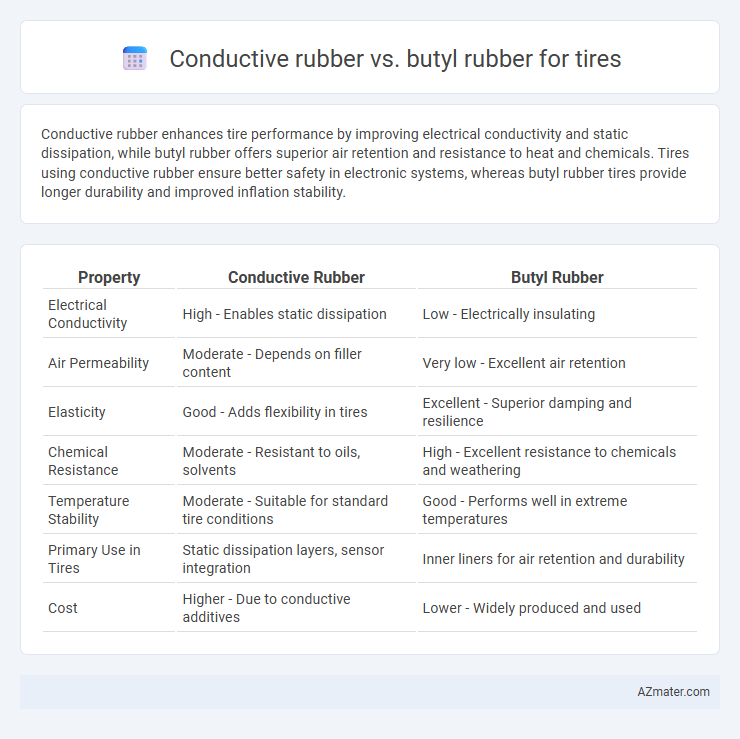Conductive rubber enhances tire performance by improving electrical conductivity and static dissipation, while butyl rubber offers superior air retention and resistance to heat and chemicals. Tires using conductive rubber ensure better safety in electronic systems, whereas butyl rubber tires provide longer durability and improved inflation stability.
Table of Comparison
| Property | Conductive Rubber | Butyl Rubber |
|---|---|---|
| Electrical Conductivity | High - Enables static dissipation | Low - Electrically insulating |
| Air Permeability | Moderate - Depends on filler content | Very low - Excellent air retention |
| Elasticity | Good - Adds flexibility in tires | Excellent - Superior damping and resilience |
| Chemical Resistance | Moderate - Resistant to oils, solvents | High - Excellent resistance to chemicals and weathering |
| Temperature Stability | Moderate - Suitable for standard tire conditions | Good - Performs well in extreme temperatures |
| Primary Use in Tires | Static dissipation layers, sensor integration | Inner liners for air retention and durability |
| Cost | Higher - Due to conductive additives | Lower - Widely produced and used |
Introduction to Tire Rubber Compounds
Tire rubber compounds primarily consist of materials engineered to optimize performance, durability, and safety. Conductive rubber, infused with carbon black or conductive fillers, enhances electrical conductivity to reduce static buildup, improving safety in certain tire applications. Butyl rubber, characterized by its excellent air impermeability and chemical resistance, is widely used in inner liners to maintain tire pressure and extend service life.
What is Conductive Rubber?
Conductive rubber is a specialized elastomer infused with conductive fillers such as carbon black or metal particles, enabling it to dissipate static electricity effectively. This material is crucial for tire applications where static charge buildup can impair performance or safety. Compared to butyl rubber, which is primarily valued for its excellent air retention and chemical resistance, conductive rubber enhances electrical conductivity while maintaining flexibility and durability in tire manufacturing.
Key Characteristics of Conductive Rubber
Conductive rubber features a unique composition that incorporates conductive fillers such as carbon black or metal particles, enabling efficient dissipation of static electricity and improved electrical conductivity essential for tire applications. It exhibits superior abrasion resistance, flexibility, and durability compared to traditional butyl rubber, which is primarily valued for its excellent air retention and impermeability. The enhanced thermal stability and reduced rolling resistance of conductive rubber make it a preferred choice in high-performance tire manufacturing.
What is Butyl Rubber?
Butyl rubber is a synthetic rubber known for its excellent impermeability to gases, making it ideal for inner tire linings to maintain air pressure. Unlike conductive rubber, which contains additives to enhance electrical conductivity and reduce static buildup, butyl rubber prioritizes durability, chemical resistance, and airtightness in tire applications. Its unique molecular structure provides superior flexibility and resistance to heat, ozone, and weathering, contributing to prolonged tire life.
Notable Properties of Butyl Rubber
Butyl rubber exhibits excellent air impermeability, superior resistance to heat, ozone, and chemicals, making it ideal for inner tire linings to maintain consistent tire pressure. Its low gas permeability significantly reduces air loss, enhancing tire durability and lifespan. Compared to conductive rubber, butyl rubber provides better flexibility and durability under varying temperature conditions, essential for optimizing tire performance and safety.
Performance Comparison: Conductive vs Butyl Rubber
Conductive rubber offers superior electrical conductivity and enhanced wear resistance, making it ideal for tires requiring static dissipation and improved traction on wet surfaces. Butyl rubber excels in air retention due to its low permeability, providing longer tire life and better resistance to heat and ozone aging. While conductive rubber improves safety through electrostatic discharge, butyl rubber delivers enhanced durability and tire inflation stability.
Impact on Tire Safety and Functionality
Conductive rubber enhances tire safety by providing improved electrical conductivity, which helps dissipate static electricity and reduce the risk of sparks, crucial in environments prone to flammable substances. Butyl rubber offers superior air retention and resistance to chemical degradation, contributing significantly to tire durability and consistent performance under various driving conditions. The combination or choice between conductive and butyl rubber directly impacts tire safety by balancing electrical properties with airtightness and chemical stability.
Environmental and Cost Considerations
Conductive rubber enhances tire safety through improved electrical conductivity, reducing static buildup, but typically incurs higher manufacturing costs due to specialized materials. Butyl rubber offers excellent air retention and chemical resistance, contributing to longer tire life and lower maintenance expenses, with production costs generally more economical than conductive rubber. Environmentally, butyl rubber is favored for its recyclability and lower environmental impact during disposal, whereas conductive rubber's production involves synthetic additives that may pose challenges for eco-friendly waste management.
Typical Applications in the Tire Industry
Conductive rubber is primarily used in tire manufacturing for antistatic and static dissipative applications, ensuring safety in environments prone to electrostatic discharge, especially in industrial and off-road tires. Butyl rubber is favored in inner linings of tires due to its exceptional air impermeability, excellent resistance to chemicals and weathering, and ability to maintain tire pressure. The tire industry relies on conductive rubber for enhanced safety features, while butyl rubber is essential for durability and tire performance in passenger, commercial, and aircraft tires.
Choosing the Right Rubber for Tire Manufacturing
Conductive rubber offers excellent electrical conductivity and is ideal for tires requiring static dissipation and improved safety in electronic environments. Butyl rubber provides superior air retention and chemical resistance, making it the preferred choice for inner tire liners to prevent air leakage and enhance durability. Selecting the right rubber depends on the tire's intended application, with conductive rubber suited for anti-static performance and butyl rubber optimized for airtightness and longevity.

Infographic: Conductive rubber vs Butyl rubber for Tire
 azmater.com
azmater.com